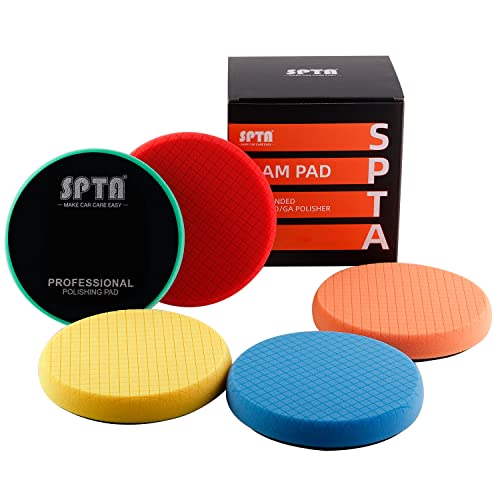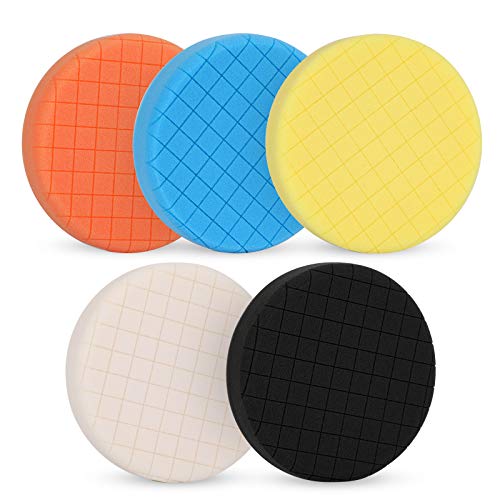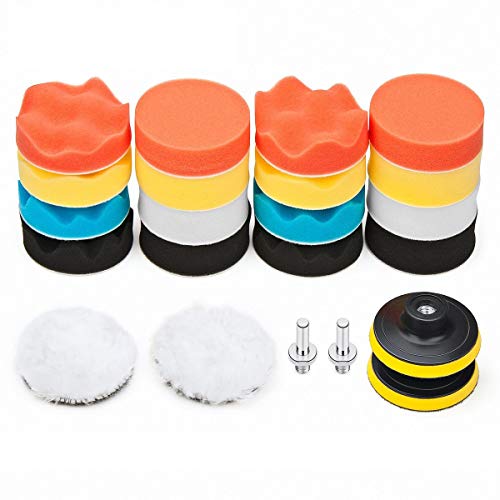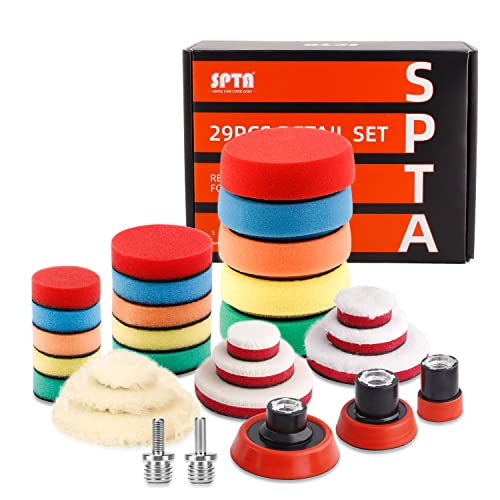If you want your car or truck to look good in the showroom, you need to take the time to polish it. That shine can be maintained with the right tools, starting with a double-action or rotary orbital polisher. However, you need to get some polishing pads to put on your polisher.
Which Pad Is Best For Car Polishing?
Using the wrong type of polishing pad can destroy or ruin your vehicle’s finish instead of improving it, or it can just be a waste of time and money if the pads you get aren’t up to the task. Along with the appropriate material, you will need to consider the cut and flexibility of the bearings.
You will also need to get the correct size polishing pads for the area you are polishing or repairing and know how to clean them to make sure they last more than one use.
Best Polishing Pads For Cars | Comparison Table 2025
Top Quality | 5- Star Pick | Great Prices
| Preview | Product | Features | Price $$ |
| SPTA Buffing Pads For Cars |
| view on Amazon | |
| AVID POWER Polishing Pads |
| view on Amazon | |
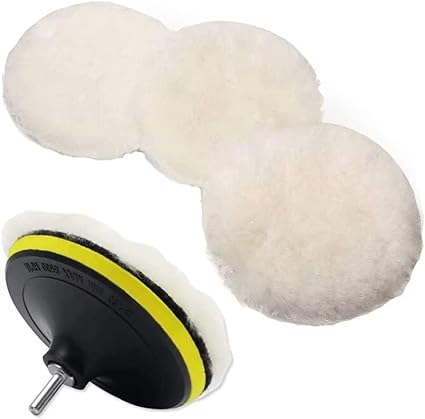 | IPELY Wool Polishing Pads |
| view on Amazon |
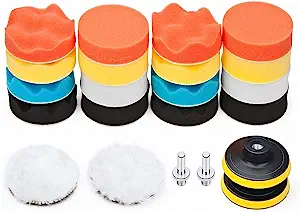 | Car Foam Drill Polishing Pad |
| view on Amazon |
| Benavvy Drill Polishing Pad |
| view on Amazon | |
| Product Name |
| view on Amazon | |
| SPTA 5.5 Inch Polishing Pad |
| view on Amazon | |
| SPTA Drill polishing kit |
| view on Amazon | |
| SPTA 29pcs Buffing Pad |
| view on Amazon |
Best Polishing Pads For Cars | 2025 Products Overview
1. SPTA Buffing Best Polishing Pads For Cars
The SPTA 5Pcs Buffing pads are designed for compounding, polishing, and waxing automotive surfaces. The set includes pads in five colors, each serving a specific purpose, from heavy cutting to finishing polish. The unique design features different sizes on each side to protect surfaces from scratches and reduce abrasion. These high-quality, bendable, washable, and reusable pads are suitable for various types of compounds.
Their advanced manufacturing technology ensures soft and fine workmanship, making them easy to use with electric buffers and other polishers. With a hook and loop backing, changing the sponge is convenient. Overall, this set is ideal for achieving optimal polishing results while being durable and cost-effective.
Product Overview:
The SPTA 5Pcs 6.5 Inch Face for 6 Inch 150mm Backing Plate Compound Buffing Sponge Pads Cutting Polishing Pad Kit is a set of five different colored sponge pads designed for use on cars to remove sun damage, scratches, and other imperfections. Each color corresponds to a specific type of polishing or waxing task: green/yellow for heavy cut, orange for medium cut, blue for light cut, and red for finish polishing and waxing.
- Multiple color options for different types of polishing and waxing tasks
- Unique design to protect surfaces from scratches while polishing
- High-quality, bendable, washable, and reusable sponge material
- Great heat dissipation capacity and locks in polishing compound
- Advanced manufacturing technology for a soft and fine finish without damage to surfaces
- Only compatible with a 6-inch backing plate
- Not suitable for very deep scratches or oxidation
- Can be difficult to change sponges if the backing plate is not designed with the hook and loop system.
2. AVID POWER Buffing Polishing Pads
The Avid Power Buffing Pads are uniquely designed with a wide top and narrow bottom to protect your car's surface from scratches during polishing. Made from high-quality imported foam, these pads offer improved heat dissipation and airflow. The square sharp sponge ensures secure locking of the polishing compound, preventing it from falling off during high-speed polishing.
The pads are washable for easy cleaning and come in a set of 5, making them versatile for various paint applications such as waxing, polishing, and sealing glaze. Enhance your car's appearance with these durable and effective buffing pads.
Product Overview:
The AVID POWER 6 Inch Buffing Polishing Pads 5Pcs is a kit designed for use with a 6-inch backing plate on a car buffer polisher. The pads are made from imported high-quality foam and feature a unique design with a wide top and narrow bottom to protect the car surface from scratches while polishing. The foam also provides better heat dissipation and improved airflow between the pad and the surface.
- Unique foam design protects the car’s surface from scratches.
- Made from imported high-quality foam for better heat dissipation and airflow.
- Square, sharp sponge design locks in the polishing compound to prevent it from falling off.
- Washable and reusable.
- Versatile can be used for all kinds of coat paints, waxing, polishing, and sealing glaze.
- Only compatible with a 6-inch backing plate.
- It needs to be air-dried after cleaning.
- It may wear off quicker if not cleaned and stored properly
3. IPELY 6 Inch Wool Polishing Pads For Cars
The IPELY Wool Polishing Pads set includes 4 thick wool pads (6 inches/150mm), 1 Adhesive Backer Pad, and 1 M14 Drill Adapter. Designed for use with angle grinders, power buffers, and polishers, these pads are made of high-quality wool that won't damage surfaces during car cleaning and polishing. They are washable and reusable, suitable for various tasks like polishing, buffing, compounding, glazing, detailing, and final finishing.
The lightweight and super soft Hook & Loop backing allows for quick mounting/removal, facilitating easy pad changes. Ideal for both car detailing and home use, these pads can be used on surfaces like shower glass, granite counters, and furniture.
Product Overview:
The IPELY 6 Pcs 6 Inch Wool Polishing Buffing Pad set includes 4 wool polishing pads, 1 adhesive backer pad, and 1 M14 drill adapter. These pads are designed for use with angle grinders, power buffers, and polishers and can be used for a variety of polishing, buffing, and waxing tasks. The pads are made of top-quality thick wool, which will not damage surfaces while cleaning and polishing.
- Made of top-quality thick wool, will not damage surfaces.
- Washable and reusable, ideal for a variety of tasks.
- Lightweight and super-soft Hook & Loop backing design for easy mounting and removal.
- Can be used for both cars detailing and other tasks.
- Comes with an M14 drill adapter for use with angle grinders, power buffers, and polishers.
- Only come in one size 6 Inches
- Not suitable for paint corrections
- Needs to be washed and properly maintained to prolong its life.
4. Petutu Car Foam Drill Polishing Pad
The Petutu Car Foam Drill Polishing Pad has 16 sponge polishing pads, 2 woolen buffer pads, 2 drill adapters, and 2 suction cups. Suitable for waxing, polishing, and sealing glaze on various coat paints, as well as auto car detailing. The high-quality wool and sponge pads are bendable, washable, and reusable. Different colored sponges offer varying softness for polishing rough and small areas.
Designed for professional buffing, polishing, and finishing, this system efficiently cuts and polishes car oxidation coating and scratches. The adhesive backing allows for quick pad changes, and all sponge polishing pads should be cleaned and leveled before use. Suitable for use with pneumatic or electric polishing machines.
Product Overview:
The Petutu Car Foam Drill Polishing Pad Kit is a 22-piece set that includes 3-inch buffing pads for polishing and finishing a variety of surfaces. The kit includes 16 sponge polishing pads, 2 woolen buffer pads, 2 drill adapters, and 2 suction cups. It is suitable for use on all types of coat paints, including waxing, polishing, and sealing glaze to improve their shine and clarity. The kit can also be used for auto car detailing. The pads have an adhesive backing, which allows you to change pads quickly and easily.
- Comprehensive kit with all necessary components for polishing and detailing cars.
- High-quality materials that are bendable, washable, and reusable.
- Different colored sponges have varying levels of softness, suitable for polishing different surfaces.
- Can be used with pneumatic or electric polishing machines.
- Advanced manufacturing technology, excellent selection, and easy to replace pads.
- All sponge polishing pads must be cleaned and leveled before use.
- Pads need to be cleaned and dried immediately after use.
- Not suitable for certain types of surfaces, may not produce desired effect without proper usage.
5. Benavvy Polishing Pad
The Benavvy 39pcs Drill Polishing Pad is a comprehensive 30-piece set for automotive polishing, featuring various sponge pads, drill adapters, suction cups, and woolen buffers. The differently colored sponges indicate varying softness levels, with orange and white designed for coarse polishing, yellow for medium, and black and blue for fine polishing. The wave polishing pads are ideal for coarse tasks like waxing, while others excel in fine polishing and sealing.
Crafted from high-quality materials, these pads are durable and reusable, ensuring efficient removal of automotive oxide coatings and scratches. The set is versatile, suitable for waxing, polishing, and sealing glaze on various surfaces, enhancing brightness, and applicable with pneumatic or electric polishing machines. The product emphasizes premium quality and ease of use with washable and replaceable components.
Product Overview:
The Benavvy 39pcs Drill Polishing Pad Kit is a 2-in-1 car foam drill and buffing pad set designed for polishing and finishing automotive surfaces. The kit includes 30 sponge polishing pads in a mix of 25 3" pads and 5 5" pads, 3 drill adapters (2 3" and 1 5"), 3 suction cups (2 3" and 1 5"), and 3 woolen buffers (2 3" and 1 5"). The pads are made of high-quality materials and can be used repeatedly.
- The kit includes a variety of pads for different levels of polishing.
- Made of high-quality materials that can be used repeatedly.
- Efficiently cuts and polishes difficult automotive coatings.
- Can be used for waxing, polishing, and sealing various surfaces.
- Reusable and easy-to-replace liners with adhesive gaskets.
- Suitable only for polishing cars and not other surfaces.
- May not be suitable for heavy polishing jobs.
- Drill and polisher are not included in the kit.
6. SPTA Buffing Polishing Pad 5.5 Inch
The product is a set of compounding, polishing, and waxing sponge pads designed for automotive detailing. The set includes five different colored pads with varying levels of cut for different polishing needs. The unique design features different sizes on two sides to protect surfaces from scratches while polishing.
The pads are high-quality, bendable, washable, and reusable, with advanced manufacturing technology for soft and fine workmanship. They are compatible with various polishing compounds and can be used with electric buffers. The set is recommended for auto car detailing and is easy to use, with a hook and loop backing for easy sponge changes. The pads are washable and durable, suitable for multiple uses.
Product Overview:
The SPTA 5Pc 5.5 Inch Face for 5 Inch 125mm Backing Plate Compound Buffing Sponge Pads Cutting Polishing Pad Kit is a set of five different colored sponge pads that are designed for use with a car buffer or polisher. The pads are suitable for a variety of tasks, including compounding, polishing, and waxing. Each color represents a different level of abrasiveness, with green and yellow being the most abrasive (for heavy cut and removing oxidation coating and moderate to light scratches), orange (for medium cut and removing sun abuse and swirl mask), blue (for light cut and polish), and red (for finish polishing and waxing).
- Five different colored sponge pads for a variety of tasks
- Unique design to protect the surface from being scratched
- High-quality, bendable, washable, and reusable sponge material
- Advanced manufacturing technology with soft and fine workmanship
- Easy to use with a hook and loop backing
- The pads may not be durable for heavy use and frequent use
- Some users may find the pads to not be as effective as expected
- The pads may fall apart after frequent washing
7. SPTA Drill polishing kit
The SPTA Car Foam Drill 3-Inch Buffing Pads are designed for various applications such as cars, furniture, wood products, glass, and stainless steel. The package includes 8 sponge pads, 1 woolen buffer, and 1 threaded drill adapter, catering to different polishing needs.
The pads are made of high-quality, super-absorbent materials that are soft and delicate, ensuring no scratches on surfaces. The Velcro design on the polished back plate allows for easy pad replacement, and a standard drill adapter is included for convenient use with drills. The set is suitable for pneumatic or electric polishing machines, offering a quick and effective polishing solution.
Product Overview:
The SPTA Car Foam Drill 3-Inch Buffing Pad is a polishing kit that includes 11 different pieces, including 5 sponge pads, 1 wool buffer, 1 white microfiber pad, 1 gray microfiber pad, and 1 threaded drill adapter. These various pads and buffers are made of high-quality materials that are designed to be super absorbent, gentle, and not scratch surfaces. They are also designed to be durable and long-lasting, with excellent strength and plasticity. These pads are perfect for polishing cars, furniture, wood products, glass, stainless steel, and precision instruments without damaging their surfaces.
- Made of high-quality materials.
- Super absorbent and gentle on surfaces.
- Long-lasting and durable.
- Variety of pads and buffers included.
- Equipped with a standard drill adapter.
- May not be suitable for heavy-duty or commercial use.
- The drill adapter is only compatible with certain types of drills.
- Not suitable for all kinds of surfaces or materials polishing.
8. SPTA Buffing Polishing Pad 7.5 Inch
This SPTA Buffing Polishing pad is designed for compounding, polishing, and waxing your car. The set includes five different colored pads for various tasks, such as heavy cut, medium cut, and light cut or finish polish. The unique design with different sizes on each side helps protect surfaces from scratches during polishing.
These high-quality pads are bendable, washable, and reusable, providing efficient heat dissipation and preventing the polishing compound from falling off. Suitable for use with electric buffers, they are easy to assemble and recommended for auto car detailing. The set is also ideal for polishing resin products, tables, and floors.
Product Overview:
The SPTA Buffing Polishing Pads are a kit of five different colored sponge pads designed for use with a 7-inch backing plate. The pads are 7.5 inches on the front side and 7 inches on the back side, with a unique design that helps to protect surfaces from scratches while polishing.
- The kit includes 5 different colored pads for different levels of polishing and waxing.
- Unique design to protect surfaces from scratches while polishing.
- Made from high-quality, bendable, washable, and reusable sponge material.
- Can be used with a variety of electric buffers.
- Pads have great heat dissipation capacity.
- Some users may find the pads wear out relatively quickly
- Some users may find the pads are not dense enough to cut heavily oxidized paint
- Some users may find the pads have minimal finish capabilities
9. SPTA Drill Buffing Pad
The product is a comprehensive polishing pad set for automotive care, including 24 mixed polishing and wool pads, 3 mixed-size backing pads, and 2 adapters. Suitable for various paint applications, the high-quality pads are bendable, washable, and reusable. Different colored sponges offer varying softness for polishing different areas.
The set efficiently cuts and polishes car oxidation, scratches, and more. Compatible with pneumatic or electric polishing machines, the pads come with adhesive backing for quick changes. Ideal for enhancing the lightness of coat paints and auto car detailing.
Product Overview:
The SPTA 29pcs Drill Buffing Pad Detail Polishing Pad Mix Size Kit is a collection of polishing and wool polishing pads, backing pads, and adapters designed for use on all types of coat paints. The kit can be used for a variety of tasks, including waxing, polishing, and sealing glaze, as well as for detailing cars. The kit includes 24 mixed polishing and wool polishing pads, 3 mixed-size polishing backing pads, 2 adapters, and the company's best service.
- Comprehensive kit with a variety of pads for different tasks.
- Pads are made of high-quality materials that are washable and reusable.
- Pads come in different colors and levels of softness for different surfaces.
- Adhesive backing allows for easy and quick pad changes.
- The kit includes adapters and backing pads for added convenience.
- It may require the additional purchase of a drill to use this kit.
- Some customers may find the pads less durable than they were expecting.
- It is possible that the product may not work as well as intended on certain surfaces or coatings.
Features To Consider While Choosing the Best Polishing Pads For Cars in 2025 | Ultimate Buyers Guide
Key Considerations
There are three different types of polishing pads, each of which is used for a different purpose. The type of pad you need is determined by what you are trying to do. If you are repairing or restoring your vehicle, you will need rougher, stiffer polishing pads that can polish away the repair compounds you used to fill in dents and scratches.
To maintain that showroom look, you'll need softer, more flexible polishing pads to bring the luster back to your car paint with polish and car wax.
Composite polishing pads
Compound or Cut-Off polishing pads are the first pads you should use on the rougher surface of your vehicle that needs more work. These bearings will cut through your car's composite materials when repairing dents and scratches.
Polishing pads
Use these polishing pads as a second step to repair or restore your car's appearance. They are used to polish cars with enamel and restore luster.
Finishing polishing pads
These soft pads are used with car wax or sealant as the last step to restore your car's appearance.
Material
There are three main materials used for polishing pads. Each has its own advantages and disadvantages.
- Foam: Foam is the most common material used for polishing pads. It can be adjusted during the manufacturing process to suit any need, from composition to polishing and finishing. The foam pads can be textured with waffle patterns, hex logic, and CCS to keep the car polish in place during use. The foam pads have an open or closed-cell structure. Open-cell types hold enamel better than closed-cell pads but are more difficult to clean.
- Microfiber: Microfiber polishing pads can be used for cutting and composing, as well as for polishing and finishing. They are flat pads that tend to have a longer life than foam pads.
- Wool: Polishing pads were originally made of wool. However, wool is inherently rough, which makes it difficult to use without scratching or marring the paint. Foam and microfiber pads have replaced fleece pads in most cases, although fleece still finds its use in composite pads.
Flexibility
It is important to get a polishing pad that is flexible. Otherwise, the polish will not be applied and polished evenly. A stiff pad could ruin the paint very quickly. That said, a stiffer pad should be used for large, flat surfaces in your car, and you should maintain constant motion when using it.
Cut
Cutting a polishing pad refers to how aggressive it is. The more aggressive the pad, the faster it will remove scratches and blemishes. However, aggressive bearings will not leave a smooth finish. A less aggressive pad will take longer to remove blemishes, but the finish it leaves will be much smoother.
Diameter
The diameter of a polishing pad should be the same size or slightly larger than the backplate of the polisher. Smaller bearings are preferable for confined areas, while larger bearings are better for flat, unobstructed surfaces such as hoods, doors, and the vehicle roof.
Accessories
Conditioning Brushes: Griot's Garage Conditioning Pad Brush You can use this Griot's Garage Conditioning Brush to keep your polishing pads free of contaminants. Use the brush on the polishing pad while slowly turning it on your polisher.
Straight Tool Cleaning: TCP Global Polishing and Polishing Pad Cleaning Guide Tool When there are polishes, enamels, and other hardened compounds on the polishing pad, use this cleaning tool from TCP Global to break them. Just slide the metal swivel head over the pad as you spin. The dirt will disappear in no time.
Polishing Pad Cleaners: McKee 37 Polishing Pad Rejuvenator Sometimes the water is not enough to clean polishing pads. This McKee 37 Citrus Based Degreaser Liquid can crumble any polish or wax, cleaning the polishing pad without leaving any residue.
prices of polishing pads
Under $ 10 is the low price range for polishing pads. In this range, you will find microfiber pads and small polishing pads.
From $ 10 to $ 30 you'll find complete kits of different types of polishing pads, hex logic polishing pads, and larger diameter pads.
Over $ 30, you'll find larger kits with more pads. The greater the number of polishing pads, the finer the gradation you will find between each pad, giving you more control over the final look of your vehicle.
Advice
- Although polishing pads can be used by hand, especially microfiber pads, you will get the best (and safest) results if you use them with a dual-action orbital polisher.
- Wool is an extremely aggressive material. Wool polishing pads should only be used by automotive professionals.
- Wool polishing pads are generally used on rotary polishers, rather than double-action orbital polishers.
What Is The Difference Between Buffing And Polishing Pads?
Buffing and polishing pads are both used to apply compounds or polishes to the surface of a vehicle, but they are used for different purposes and have different characteristics.
Buffing pads are generally used with a heavy cutting compound to remove heavy imperfections such as oxidation, deep scratches, and swirl marks. They are typically made of coarser material, such as wool or a dense foam, and are designed to remove a significant amount of material from the surface of the paint.
Polishing pads, on the other hand, are used with a light polishing compound to remove light imperfections and restore the shine to the paint. They are typically made of a softer material, such as foam, and are designed to remove less material from the surface of the paint. They are used after the cutting process to refine the finish and give a glossy look.
In summary, buffing pads are used for heavy correction and polishing pads are used for refinement.
Frequent questions
What Buffing Pad To Use To Remove Scratches?
To remove scratches from a car's paint, you would typically use a buffing pad along with a heavy cutting compound. The best type of buffing pad to use for this purpose is typically one made of wool, which is known for its ability to remove heavy imperfections quickly and efficiently.
A wool pad works by breaking down the abrasive particles in the cutting compound and holding them in the fibers of the pad, allowing them to cut into the surface of the paint and remove the scratches. The stiff fibers of the wool pad also helps to level out the clear coat and to remove deep imperfections.
It's important to note that when using a wool pad, it's necessary to be more cautious as it can cause marring if not used correctly. The pad should be in a clean condition, with no debris in it, and also the pressure applied must be moderate. It is important to use proper technique and a controlled motion, and it is also recommended to follow up with a finishing pad and polishing compound to restore the shine of the paint and eliminate any holograms or marring caused by the wool pad and cutting compound.
What Kind Of Pad Is Best For Polishing With A Buffer?
When using a buffer to polish a car's paint, the best type of pad to use is a foam pad. Foam pads come in different densities, and the density of the pad you choose will depend on the type of polish you are using and the condition of the paint.
- A softer foam pad, such as a white or yellow pad, is generally used with a light polishing compound to remove light imperfections and swirl marks.
- A medium-density foam pad, such as an orange pad, is generally used with a medium polishing compound to remove moderate imperfections.
- A firmer foam pad, such as a black pad, is generally used with a heavy cutting compound to remove heavy imperfections.
It's important to note that foam pads also come in different shapes and sizes, some are smaller and others are bigger, depending on the surface you are working on. A smaller pad will allow for more control and precision in tight areas, while a larger pad will cover more surface area and make the polishing process quicker.
In general, foam pads are preferred over wool pads for polishing as they tend to produce less heat, and are less likely to cause marring or holograms in the paint, they also tend to be more gentle and produce a better finish. It's also important to use a clean pad and not to use a worn-out one to avoid damage to the paint.
Is Wool Or Foam Better For Polishing?
When it comes to polishing a car's paint, foam pads are generally considered to be better than wool pads.
Foam pads come in different densities and are designed to be used with different types of polishing compounds, from light polishing to heavy cutting. They are gentle on the paint, produce less heat, and are less likely to cause marring or holograms in the paint, which can be a concern with wool pads. Foam pads also tend to produce a better finish, as they are able to refine the surface more effectively.
Wool pads, on the other hand, are more aggressive, they tend to remove more material and they are more suitable for heavy cutting, such as removing oxidation, deep scratches, and heavy swirl marks. They are less refined and tend to cause more marring and holograms if not used properly. Wool pads also tend to produce more heat and it's important to be cautious when using them.
In summary, both wool and foam pads have their own strengths, wool is more suitable for heavy cutting, while the foam is preferred for polishing and refinement. Depending on the condition of the paint, you will have to use different types of pads and compounds. It is generally recommended to use a foam pad for polishing and a wool pad for heavy cutting, then follow up with a foam pad for refinement and final finish.
What Do The Colors Of Polishing Pads Mean?
Different colored polishing pads are used for different purposes and are typically made from different types of foam with varying densities. The color of a polishing pad can indicate its intended use, as well as the level of aggressiveness it has.
- White or yellow pads: These pads are generally the softest and most gentle. They are used with a light polishing compound to remove light imperfections and swirl marks. They are suitable for use on freshly painted or delicate surfaces.
- Orange pads: These pads are of medium density, are versatile, and are used with a medium polishing compound to remove moderate imperfections. They are suitable for use on most types of paint and can be used as an all-purpose pad.
- Black pads: These pads are the most aggressive, they are denser than the white or yellow pads and are used with a heavy cutting compound to remove heavy imperfections and restore paint. They are suitable for use on older or heavily damaged paint surfaces.
- Blue pads: These pads are considered finishing pads, they are less aggressive than the orange pads and less dense than the black pads. They are used with a final polishing compound to refine the finish and bring out the shine of the paint.
- Green pads: These are specifically designed for use with ceramic coatings and sealants, they are less abrasive than other pads and tend to be on the softer side. They are used to maintain and revive the ceramic coat.
It's important to note that the color code for pads can vary by brand, so always check the manufacturer's recommendations or specifications before using a pad. Always use a clean pad and make sure it is not worn out to avoid damage to the paint.
Do I Need To Wet The Polishing Pad?
Whether or not to get a polishing pad before use depends on the type of polish or compound you are using, as well as the type of pad.
For some compounds and polishes, it is recommended to use a damp or wet pad. When using these types of products, the water in the pad helps to cool the surface and prevent the polish from drying too quickly. Additionally, a wet pad can help to distribute the product evenly over the surface, and also reduce the amount of dust generated by the polishing process. It is important that the pad is not too wet otherwise it will cause the polish to be splashed around and also affect the polishing process.
On the other hand, some compounds and polishes are designed to be used with a dry pad. For these types of products, using a damp or wet pad can negatively affect the polishing process by reducing the effectiveness of the polish, and also causing too much slippage between the pad and the surface.
It's important to check the manufacturer's recommendations for the polishing product you are using and follow the instructions. Generally, a foam pad can be wet, but a wool pad should be kept dry. Also, you should use clean water to dampen the pad and make sure it's not too wet, otherwise, it can create a mess and will also affect the polishing process.
How Many Pads Needed To Polish A Car?
The number of pads needed to polish a car will depend on the condition of the paint and the type of polishing process you are using.
For a standard polishing process, it is common to use at least 3 different pads:
- A cutting pad: typically a black or wool pad, removes heavy imperfections such as oxidation, deep scratches, and swirl marks.
- A polishing pad: typically an orange pad, is to remove moderate imperfections and to refine the surface of the paint.
- A finishing pad: typically a blue or white pad, is to produce a glossy finish, remove any remaining fine imperfections, and also to remove any haze or marring caused by the previous steps.
However, depending on the condition of the paint, it may be necessary to use additional pads or to use a more aggressive pad for the initial cutting step. Additionally, if you are doing a multi-step process, such as applying a ceramic coating or paint correction, the number of pads needed may be higher.
It's important to remember that each pad will wear out over time, and it's important to use a clean pad and also to replace them as soon as they become worn out. Using worn-out pads can damage the paint, and also make the polishing process less effective.
In summary, the number of pads you need to polish a car depends on the condition of the paint, the type of polishing process, and the desired result. Typically, a standard polishing process requires at least 3 pads, but it can vary. Make sure to check the pad condition and replace them when needed.
What Pad Removes Swirl Marks?
Swirl marks are fine scratches that appear on the surface of a car's paint, caused by improper washing or drying techniques, or by using a dirty or worn-out pad during the polishing process. To remove swirl marks, you typically need to use a polishing pad along with a polishing compound.
- For light swirl marks, a soft foam pad such as a white or yellow pad along with a light polishing compound can be used.
- For moderate swirl marks, a medium foam pad such as an orange pad along with a medium polishing compound can be used.
- For heavy swirl marks and deeper imperfections, a firmer foam pad such as a black pad along with a heavy cutting compound can be used.
It's important to note that the type of foam pad and compound you use will depend on the condition of the paint and the severity of the swirl marks, always check the manufacturer's recommendations for the product you're using. Additionally, it's important to use a clean pad, with no debris and also to use moderate pressure and proper technique to avoid creating more damage to the paint.
It's also important to remember that removing swirl marks is a multi-step process, you may need to start with the more aggressive pad and compound, then follow up with a softer pad and compound to refine the finish and remove any haze or marring caused by the previous steps. Always finish the process with a finishing pad and polishing compound to restore the shine of the paint.
How Do Body Shops Buff Out Scratches?
Body shops typically use a multi-step process to buff out scratches on a car's paint. The process typically involves using a combination of buffing pads, polishing compounds, and machine polishers.
Here's a general overview of the process:
- Inspection: Before beginning the buffing process, the technician will carefully inspect the vehicle to determine the severity of the scratches and to identify any other imperfections that may need to be addressed.
- Cleaning: The car is then cleaned to remove any dirt or debris that may be on the surface of the paint.
- Heavy Cutting: Using a heavy cutting compound, wool, or black pad, the technician will buff out the scratches using a rotary machine polisher. The aim of this step is to remove the scratches, oxidation, and other heavy imperfections.
- Refining: Then, using a medium cutting compound, orange pad, and machine polisher, the technician will refine the surface of the paint, this step aims to remove any other imperfections that may be left on the surface and also to restore a smooth surface.
- Finishing: Finally, using a light polishing compound and a finishing pad such as blue or white, the technician will use a machine polisher to give a glossy finish and remove any haze or marring caused by the previous steps.
- Detail: After the paint is buffed, the technician will perform a final detailing of the car, which includes washing, drying, and waxing or sealing to protect the finish and bring out the shine of the paint.
It's important to note that the buffing process can vary depending on the condition of the paint and the severity of the scratches. Some heavy scratches may need to be repainted, the body shop will take that decision after the inspection. Also, the process can take some time, as each step should be done carefully and with the right techniques, to avoid damaging the paint.
Should I wash my car before using a polishing pad?
Yes. Polishing your car should be the last step in cleaning or repairing dents and scratches. Otherwise, the polishing pad will pick up the dirt and use it as sandpaper on your car's paint.
What is the best way to dry a polishing pad after cleaning it?
Place it upside down on a clean cooling grid with the velcro on top. This helps moisture escape from the polishing pad instead of accumulating on the velcro back.
What is the best long-term storage for polishing pads?
Once dry, place the polishing pads in a zip-free bag. There may still be moisture due to moisture on the bearings. Closing the bag traps moisture and could cause mold or rot. Leaving the bag open allows the polishing pads to breathe.
The verdict
Choosing the Best Polishing Pads For Cars is not easy and for many of them, it could be a time-consuming task. However, with this guide, my goal is to help you guys find the perfect car polish for your needs.
I've done a huge amount of research to make sure the options I've listed are among the best. As mentioned above, I also interviewed a lot of experts to make sure the recruited models are of high quality.
Hope you can find the right car polish for your use. If you're still struggling to find one, feel free to comment below or contact me.

Hi, I am David Bailey a dedicated writer from Linden Bridge School with a degree in mechanical engineering and a degree in marketing. I strive to simplify complex subjects and like to explain complex and technical matters in an easy-to-understand manner. Read More Here
